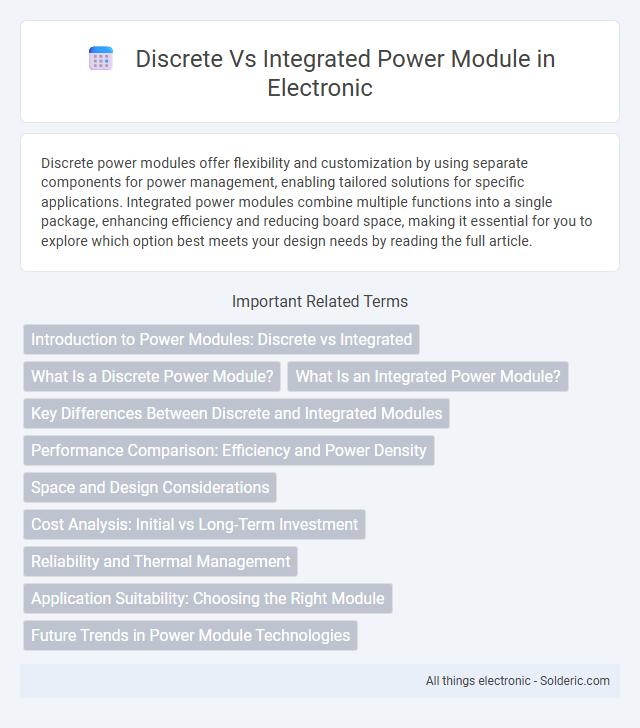Discrete power modules offer flexibility and customization by using separate components for power management, enabling tailored solutions for specific applications. Integrated power modules combine multiple functions into a single package, enhancing efficiency and reducing board space, making it essential for you to explore which option best meets your design needs by reading the full article.
Comparison Table
| Feature | Discrete Power Module | Integrated Power Module |
|---|---|---|
| Components | Separate MOSFETs, drivers, and passives | All components combined in single package |
| Size | Larger PCB footprint | Compact, reduced board space |
| Thermal Management | Individual heat sinking required | Integrated thermal solutions |
| Ease of Design | Complex layout and routing | Simplified design and faster time-to-market |
| Cost | Lower initial component cost | Higher initial cost but reduced assembly cost |
| Performance | Optimizable component selection | Optimized efficiency and switching performance |
| Application | Custom, high power designs | Compact space-constrained designs |
Introduction to Power Modules: Discrete vs Integrated
Discrete power modules consist of separate components such as transistors, diodes, and inductors, offering flexibility in design and customization for specific applications. Integrated power modules combine these components into a single compact unit, enhancing efficiency, reducing size, and simplifying assembly in power management systems. Your choice between discrete and integrated solutions depends on factors like design complexity, thermal management, and space constraints.
What Is a Discrete Power Module?
A discrete power module consists of individual electronic components such as transistors, capacitors, and resistors assembled separately on a single board to manage power conversion and regulation. These modules offer flexibility in design customization and are ideal for applications requiring tailored power solutions and easy component replacement. Discrete power modules are commonly used in industrial and automotive systems where specific performance parameters must be met without relying on pre-integrated solutions.
What Is an Integrated Power Module?
An integrated power module combines multiple power components, such as MOSFETs, drivers, and controllers, into a single, compact unit to improve efficiency and simplify circuit design. Unlike discrete power modules where individual components are separately packaged, integrated power modules reduce board space, enhance thermal management, and minimize parasitic inductances. These modules are commonly used in applications like automotive electronics, industrial systems, and power supplies to deliver reliable and efficient power conversion.
Key Differences Between Discrete and Integrated Modules
Discrete power modules consist of separate components such as transistors, diodes, and resistors, offering customization and easier thermal management but requiring more PCB space. Integrated power modules combine these elements into a single compact package, enhancing efficiency, reducing electromagnetic interference, and simplifying assembly. Your choice depends on factors like design complexity, space constraints, and thermal requirements, with integrated modules favored for compact systems and discrete modules preferred for flexible, high-power applications.
Performance Comparison: Efficiency and Power Density
Integrated power modules typically offer higher efficiency and power density due to reduced parasitic inductance and improved thermal management compared to discrete power modules. Discrete power modules, while flexible in design, often experience greater energy losses and larger footprints resulting in lower overall efficiency and power density. Advanced packaging techniques in integrated modules contribute to enhanced switching performance and compactness, making them preferred for high-performance power applications.
Space and Design Considerations
Discrete power modules require more PCB space due to separate components like inductors, capacitors, and MOSFETs, which can complicate board layout and increase design time. Integrated power modules combine these components into a single compact package, significantly reducing board footprint and simplifying thermal management, making them ideal for space-constrained applications. Your design benefits from integrated modules by optimizing space without sacrificing performance, enhancing overall system efficiency and reliability.
Cost Analysis: Initial vs Long-Term Investment
Discrete power modules typically exhibit lower initial costs due to simpler components and ease of sourcing, making them suitable for budget-sensitive projects. Integrated power modules, while carrying higher upfront expenses, offer significant long-term savings through improved efficiency, reduced board space, and lower maintenance requirements. Evaluating total cost of ownership reveals integrated solutions often deliver better ROI by minimizing thermal management and enhancing system reliability over time.
Reliability and Thermal Management
Integrated power modules offer superior reliability due to reduced solder joints and minimized interconnects, lowering the risk of mechanical failure compared to discrete power modules. Enhanced thermal management is achieved in integrated modules through optimized heat dissipation paths and compact design, which efficiently conduct heat away from critical components. Discrete modules require careful layout and additional cooling solutions, often resulting in higher thermal resistance and potential hotspots that impact long-term performance.
Application Suitability: Choosing the Right Module
Discrete power modules offer flexibility and customization ideal for applications requiring specific component selection and individual optimization. Integrated power modules suit compact, space-constrained designs where simplified assembly and improved thermal management enhance reliability. Your selection depends on balancing design complexity, space limitations, and performance requirements for optimal application suitability.
Future Trends in Power Module Technologies
Future trends in power module technologies emphasize the shift from discrete components to highly integrated power modules featuring advanced semiconductor materials like SiC and GaN for improved efficiency and thermal performance. Integration of intelligent control circuits and sensor technologies enhances real-time monitoring and fault detection, supporting Industry 4.0 applications. Moreover, miniaturization and modular design enable scalable solutions for electric vehicles, renewable energy systems, and smart grids, driving the evolution of compact, reliable, and energy-efficient power management.
Discrete vs Integrated power module Infographic

 solderic.com
solderic.com